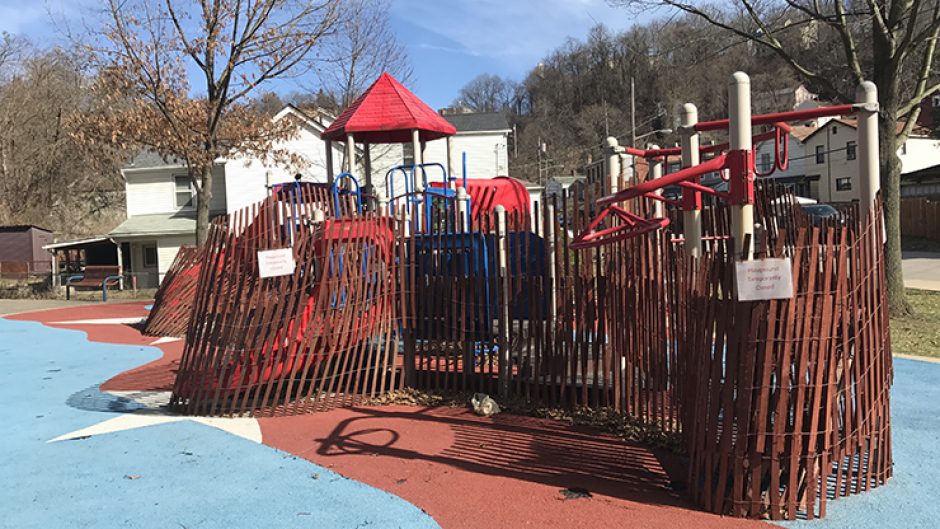The COVID-19 emergency has shone a harsh light on Pittsburgh’s funding priorities. One glaring example is the Mon-Oakland Connector (MOC), a controversial luxury microtransit project that primarily serves the Hazelwood Green development and has earned distrust from residents of affected communities.
The foundations that own Hazelwood Green imagine it as a second campus for CMU and Pitt. In a 2009 report, the Remaking Cities Institute of Carnegie Mellon University called a dedicated connection between Oakland and Hazelwood “the singular most important gesture that will ensure the success of the ALMONO site’s redevelopment.” (emphasis in original)
“What was problematic before the pandemic became unconscionable in this climate,” said Laura Wiens, director of Pittsburghers for Public Transit. “Funding this project would mean that other critical needs aren’t being met right now.”
Pittsburgh, like many cities, was hit hard. “Our tax revenues cratered, and there is still no clear path forward to replace them,” Mayor Bill Peduto stated in his 2021 budget speech. Pittsburgh faced a $55 million operating budget deficit at the close of 2020, and is depending on federal aid to avoid $25.6 million in personnel cuts starting in July 2021. About 634 city employees stand to lose their jobs.
A unanimously-approved budget amendment proposed by Councilman Corey O’Connor, whose district includes two MOC-affected communities, moved $4.15 million from the MOC. Those funds made up the 2021 budget for the MOC. They were redirected to the Housing Opportunity Fund (this citywide program received $1.9 million—$750,000 of which is earmarked for the Flats on Forward development in Squirrel Hill, leaving a little over half for Pittsburghers struggling to stay in existing housing), support for small businesses, and infrastructure improvements in Hazelwood.
Yet plans move forward to build the MOC shuttle road through Schenley Park and adjacent neighborhoods. Almono Partners spokesperson David Caliguiri said the foundations “believe the Mon-Oakland Connector remains a critical economic development effort for the City of Pittsburgh and the entire region” and are committed to funding the shuttle service. MOC may have lost 2021 funds from its total price tag of $23 million, but it’s still flush with an unknown portion of $14.5 million already granted in the 2018 and 2019 budgets.
The MOC has a long, shady history (its most recent chapter began with a fraudulent grant application to the Pennsylvania Department of Community and Economic Development) and continues to function as a magic-bag project with components and costs that morph according to justifications needed for it at any given time. For example, Pittsburgh’s Department of Mobility and Infrastructure (DOMI) claimed in a January 2020 memo that Irvine St./Second Ave. sidewalk repairs in Hazelwood—a key component of the community-generated Our Money, Our Solutions alternative plan—was always part of the MOC. By October, DOMI’s commitment to fund those repairs had vanished from the MOC budget.
For some neighborhoods—especially Panther Hollow and The Run—harm from the MOC goes beyond diverting limited resources. Two groups of residents in The Run are at risk of being displaced by the shuttle road: those who live near Swinburne Bridge, which DOMI has decided to replace rather than repair so the bridge can be widened for a dedicated MOC shuttle lane; and those who live in flood-prone areas near Big Jim’s.
The first group has already received letters from DOMI implying the City may use eminent domain to take property for the bridge replacement. The second group is some or all of the “affected properties” listed in PWSA documents concerning their Four Mile Run Stormwater Project. These internal documents, obtained through Right-to-Know requests, also reveal that the stormwater project was designed around the MOC and will not adequately protect people’s homes. One proposed solution involves a “discussion regarding property acquisition and other discussions that will not be widely popular.” The stormwater project, for which the PWSA secured $40 million, was billed as a solution to The Run’s flooding problem. But less than half of those funds are being spent on stormwater work in Schenley Park. According to PWSA acting senior manager of public affairs Rebecca Zito, “The remaining funding can go towards future projects in the upper portions of the watershed, provide opportunities to collaborate with the universities and other community organizations on future stormwater projects, or revisit some of the original green infrastructure projects planned for Panther Hollow Stream and Phipps Run.” (emphasis added)
Besides forcing families out—some of whom have lived in The Run for three generations—the legally questionable use of eminent domain to serve a development project also removes affected properties from the tax rolls. About 40% of land in Pittsburgh is already tax-exempt because the government, universities, and other non-profits own it.
A lack of accountability and transparency surrounding the MOC has allowed DOMI to plan at will behind a screen of public-facing gestures since the department’s inception in 2017. But signs point to a reckoning for the MOC. According to the TransitCenter organization, “PPT is working with the city auditor to assess options for formally moving the money, and to make recommendations about how that money should be spent.”
In past years, City officials have answered public calls to defund the MOC by saying those capital budget funds can’t be applied to other areas of need like the operating budget. This position becomes harder to maintain now that $1.9 million has been moved from the MOC to the Housing Opportunity Fund, decidedly not part of the capital budget.
There is no shortage of ways Pittsburgh could reallocate $14.5 million to meet critical needs of residents. Keeping those funds in reserve for an unpopular, top-down project like the MOC is a disgrace in today’s austere climate.

Recent Comments